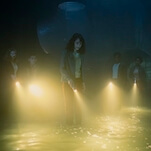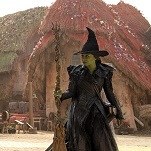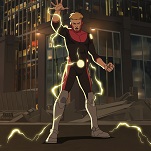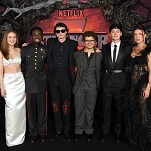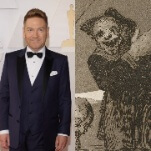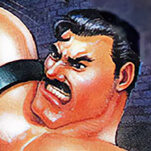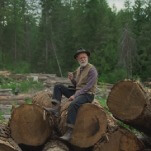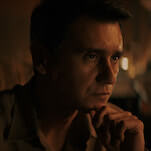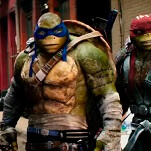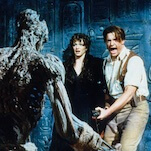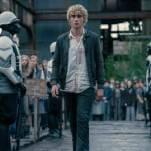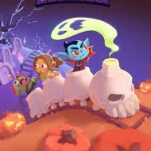Never underestimate the power of a well placed title page. Origin II #1 (Marvel) doesn’t drop the title page until the very end of the issue, after over 20 pages of Wolverine running through the Canadian wilderness with a pack of wolves and one brutal, life-altering event. Those three pages, beginning with one for “Marvel Comics Presents…” and two for the actual title, interrupt the pace of the action and force the reader to process what has unfolded before the break, heightening the impact of the tragic events that serve as the catalyst for the rest of the series. With the atmosphere of a Jack London novel and the thrills of a James Bond opening sequence, it’s one hell of a cold open, setting the stage for Kieron Gillen and Adam Kubert’s stylized continuation of the story Paul Jenkins began back in the ’00s.
One of Gillen’s major contributions to the X-titles was bringing Mister Sinister closer to his Victorian roots and characterizing the villain as the evolution of Industrial Age’s central ideas. Pitting Wolverine against Sinister is a clever way to tell a story about the conflict between nature and industry at the turn of the 20th century, and this first issue has an almost fable-like quality as it tells the story of a primal man, his adopted wolf family, and the test-subject polar bear that becomes a feral instrument of death. The complete lack of dialogue and omniscient narration contributes to the fable factor, creating an idea of what Logan’s current domestic situation is, while maintaining a certain amount of emotional distance. Logan isn’t the narrator, because currently his thoughts and actions are closer to a wolf than a human; he’s only concerned with survival for himself and his family, and the script tells his story as if he is an animal being researched, rather than a man whose life and personal feelings are being documented.
Artist Adam Kubert and colorist Frank Martin did spectacular work together on Avengers last year, and their partnership continues to deliver lush, evocative visuals on this title. Kubert does a phenomenal job creating an expansive woodland environment and evoking the sense of freedom Logan feels when he’s in this place, and Martin’s coloring adds an extra layer that brings new dimension to Kubert’s linework. The artist does particularly impressive work bringing character to the book’s animal cast, incorporating a more animated line to heighten the emotional qualities of the beasts. This first issue is light on plot, but it does a wonderful job creating a specific feeling of liberation that turns into something far less comforting by the end, pulling the reader into Logan’s experience to offer a surprisingly intimate look at the next chapter of his origin. [OS]
When it comes to crime comics, it doesn’t get much better than Darwyn Cooke’s adaptations of Donald E. Westlake’s
Parker novels. Cooke’s cinematic eye and bold design sense bring Westlake’s stories (written under the pseudonym Richard Star) to life with style and vigor, and he streamlines Westlake’s original narration and dialogue in a way that maintains the original author’s intent, while giving the art a stronger role in the storytelling.
Parker: Slayground (IDW) is an incredibly tight adaptation of an already tense story, with a pace that outraces any of Cooke’s previous
Parker graphic novels. The plot takes place over a very short period of time, during which Parker finds himself trapped in an amusement park, surrounded by gangsters and corrupt cops after a heist gone wrong, and that abbreviated time span contributes to the breakneck pacing.
Stuck inside Fun Island in the dead of winter, Parker booby traps the amusement park during a sequence that makes brilliant use of the comic book medium. The name of each different attraction appears at the top of each page, serving as a title panel for pages that capture one specific moment. (It’s a bit like reading a series of full-page comic strips in a row, where each installment stands alone, while also telling part of a larger story.) Those title panels show off Cooke’s extraordinary design sense as he produces a string of old-school logos for rides with names like Buccaneer!, Marooned!, and Galaxy Quest. That design is a huge part of the appeal of these adaptations, and Cooke’s retro styling wonderfully evokes the time period, while his animated linework and dynamic action staging elevate the story.
From the minute Parker jumps over the Fun Island fence, the reader is given a strong idea of the location the rogue finds himself in, and creating that sense of place is important in making the reader connect with the rogue’s struggle. Cooke spends the first half cultivating a feeling of comfort and safety within the amusement park limits, making it all the more satisfying when danger breaks through and Parker starts to take out his would-be killers. It’s a beautiful sight when the chaos erupts, with Cooke ingeniously finding ways to turn environmental elements like the walls of a funhouse barrel roll into strong graphic visuals. Slayground is worth the cover price for the main story alone, but to make it even more desirable, this package also includes Cooke’s adaptation of Westlake’s The Seventh, a story that previously appeared in the oversized Parker: The Martini Edition. [OS]
While history books generally eschew personal stories and take a just-the-facts approach, memoirs tend to provide the broad strokes of major events to give context to how those moments affect the main players. Elder-statesman manga cartoonist Shigeru Mizuki mixes the two in his
Showa 1926-1939: A History Of Japan (Drawn And Quarterly), alternating between a rather dry recounting of historical information—the book opens with a huge bank crisis and ends with Japan on the brink of World War II—and comedic, slapstick-tinged looks back at his own childhood, particularly his relationship with his grandmother.
Mizuki’s art similarly whips back and forth stylistically. With occasional exceptions, the history sections have a photorealistic feel, and at times the artwork is simply a reproduction of photos from the era. The memoir elements, on the other hand, have highly stylized, comic-strip-style art, with rubbery, big-featured characters that sweat giant beads of perspiration in classic manga style.
Mizuki openly breaks the rules of stylistic and tonal consistency in Showa 1926-1939. That could be grounds for criticism, but it works in a piece that functions as both historical text and memoir. Much of that success is thanks to Mizuki’s personal experience living through the era and his passion for what the big events of the time meant for Japan as a whole. The small, cartoonish world he inhabits and the bigger, more realistic world just beyond the horizon manage to co-exist within these pages, and what could be a bland history text becomes a story full of flavor. [MW]
Boom! Box is Boom! Studios’ new imprint where it gives creators on their licensed titles the opportunity to tell original stories, and it’s fitting that the team behind the publisher’s Eisner Award-winning
Adventure Time series is debuting the line’s first series.
The Midas Flesh #1 (Boom! Box) reunites writer Ryan North with artists Shelli Paroline and Braden Lamb for a series that is part sci-fi, part mythology, featuring a talking Utahraptor as one of its main characters. Half of this first issue concerns the crew of the
Prospect, a space ship that is traveling to Earth, which is a planet completely encased in gold. The answer to why comes in the other half of this issue, which retells the myth of King Midas with a far more disturbing ending that involves the monarch turning the air around him into gold—air that is touching everything else, so now the entire planet is dead.
There’s a casualness to North’s dialogue that works for the irreverent world of Adventure Time, but doesn’t translate as well to a higher stakes narrative. The story has a captivating hook, but the characters sound a bit too similar, which doesn’t make much sense when there’s more than 4,500 years distancing them. Paroline and Lamb render those two different time periods in smooth detail, and it’s nice to see what they can do when working outside of Adventure Time’s house style. The moments when Midas’ power swallows the world have a haunting beauty to them, capturing the splendor of a planet encased in gold, but also the terror of an unknown force freezing the world in shimmering stasis. The script could use some refining, but The Midas Flesh is still a promising start to an admirable new endeavor from Boom! [OS]
And…
James Robinson is a writer who does his best work when he’s allowed creative freedom. Looking at his recent DC work, it’s impossible not to notice the disparity in quality between The Shade, Robinson’s return to the rich world of his classic ’90s series Starman, and Earth 2, a book that stunk of editorial interference since day one. Robinson hasn’t worked at Image since releasing the final issue of Leave It To Chance in 2002, but the publisher’s current status as one of the leaders in creator-owned series makes it the perfect place for Robinson to let his imagination run free. The Saviors #1 (Image) sees Robinson teaming with artist J. Bone for a story that is considerably different than his recent work, following a stoner gas station employee as he discovers an alien conspiracy in his small desert town. The same attention to environment Robinson brought to the urban Opal City in Starman is evident in this title, although it’s a far smaller and more rural location. Passburg is rendered in remarkable detail by Bone (an early establishing shot provides a layout of almost the entire town), and his cartoonish design sensibility results in a cast of immediately distinct characters. Robinson delivers an intriguing script with a sympathetic lead character, but the suspense of the story is heightened by Bone’s black-and-white artwork, which helps give the book a classic Hollywood horror feel… [OS]
Paul Hornschemeier’s Artists Authors Thinkers Directors (Fantagraphics) is exactly what it looks like upon first glance: 100 pages of drawings of people’s faces, specifically the faces of people Hornschemeier loosely files into the four categories of the title. Books like this one often fall into the trap of being overwrought, but Hornschemeier accomplishes the opposite. He notes in his introduction that these are all portraits he posted to an art blog, mostly drawn late at night when he couldn’t sleep, or think of anything else to draw. These portraits are the result of not being able to think at all. The results are a minimalistic, neon Heinz Edelmann, an art deco Edward Hopper, an extremely angular J.D. Salinger, a continuous-line David Byrne, and an Andy Kaufman that looks like an R. Crumb drawing, and so on. Hornschemeier’s varied representations of the 100 people in his book aren’t necessarily in the subjects’ artistic style or representative of a milieu. They’re just what an artist felt like drawing, and that puts them in an even more thought-provoking context. It’s not necessarily a commentary on Salinger to see him in crystalline form, but it makes the reader think about what the image says about Salinger as a reclusive, hard-to-pin-down figure. Artists Authors Thinkers Directors is basically an artistic exercise, but it says a lot, maybe even more than Hornschemeier intended… [MW]
Last month, Image Comics announced the return of David Lapham’s classic Stray Bullets in March of this year. While it’s great to have Lapham back on the title that made his name, hopefully he’ll still have some time to turn out fun side projects like Juice Squeezers #1 (Dark Horse), a kid-friendly adventure series about a group of children tasked with protecting their town from being overrun by giant bugs. With a tone that falls somewhere between The Goonies and Attack The Block,
Lapham’s story places these children in the utterly terrifying situation of killing giant insects in tight underground tunnels, but the script has a sense of humor that balances the horror. This probably isn’t the best book for people that don’t like bugs (there’s a very detailed full-page spread of a giant beetle’s underside), but for everyone else, it offers a fascinating story about the resilience of youth in overwhelming circumstances. Plus, there’s plenty of bug-stomping action captured in Lapham’s stark, yet highly energetic art style, with Lee Loughridge’s coloring using different shades to convey tonal shifts when its not drenching the kids in neon yellow insect guts. Juice Squeezers is a lot of fun with a grotesque edge, a series that kids can read, but probably shouldn’t if it’s close to bedtime… [OS]
When writer Greg Pak and artist Aaron Kuder took over Action Comics two months ago, one of their first orders of business was to have Superman fight a giant monster as a way of getting to the core of the character. It was a counterpoint to the high-concept work on the title that came before it. Joining artist Paul Pelletier, new writer Jeff Parker follows the same template in Aquaman #26 (DC Comics), and surprisingly enough, it works yet again. The New 52 version of Aquaman has been depicted as a man with a chip on his shoulder, as someone who endures the same degree of ridicule in the DC Universe that Aquaman often gets from comic fans in our own world. Parker and Pelletier largely do away with that aspect of the character, or at the very least seem to knowingly avoid it, and it’s a much better comic for it. Instead of an Aquaman who is cognizant of and always trying to fight against the notion that he’s lame, this Aquaman simply finds himself engrossed as the central figure in a compelling political conflict. Then he fights a giant monster, an event that actually ties in to the political elements. Pelletier’s art isn’t too far removed from the standard DC house style, but it is as kinetic and expressive as it needs to be to get the story across. Proving that a character isn’t lame by putting him in the midst of a simple, exciting, well-told narrative doesn’t seem like a novel concept, but it feels like one here… [MW]



